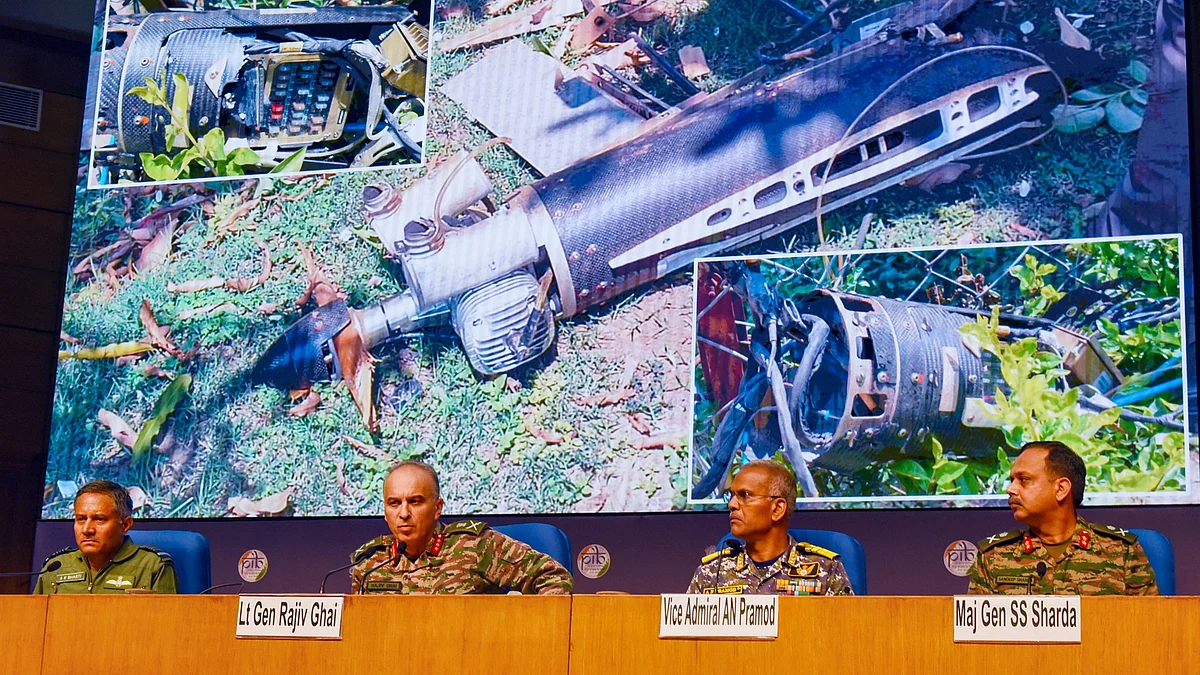100 Terrorists Dead, Airbases Damaged: What India Achieved in Operation Sindoor
Indian Armed Forces' Operation Sindoor hits terror sites, over 100 terrorists dead, 35-40 Pak army soldiers dead.

advertisement
Over 100 terrorists neutralised, 35-40 Pakistan Army personnel killed, at least nine Pakistani airbases targeted by Indian Armed forces - these are some of the key highlights of the damage that the Indian Armed Forces inflicted upon Pakistan since Operation Sindoor.
In a press briefing by the Directors General of Military Operations (DGMOs) on Sunday, 11 May, the Indian Armed Forces detailed the operation, jointly executed by the Indian Army, Air Force, and Navy.
DGMO Lieutenant General Rajiv Ghai, while addressing the media reiterated that the operation was launched with a clear military aim “to punish the perpetrators and planners of terror and to destroy their infrastructure.”
Here are details provided by the DGMO:
Terror Camps Targeted, Over 100 Terrorists Dead
The operation targeted nine terror camps located in Pakistan-occupied Jammu and Kashmir and Pakistan’s Punjab province. Intelligence agencies confirmed these sites were occupied by terrorists. Among the terrorists neutralised were high-value targets such as Yusuf Azhar, Abdul Malik Rauf, and Mudasir Ahmed, who were involved in the 1999 Indian Airlines flight (IC-814) hijacking and the 2019 Pulwama terror attack, Lt Gen Rajiv Ghai confirmed.
Air Marshal AK Bharti, Director General of Air Operations, detailed the Indian Air Force's (IAF) role: “The target systems given to the Air Force included the notorious training camps at Bahawalpur and Muridke. Through critical target system analysis, we used precision air-to-surface guided munitions to annihilate these camps while avoiding civilian harm.”
Before/after images of bases and locations targeted by Indian armed forces.
Before/after images of bases and locations targeted by Indian armed forces.
Before/after images of bases and locations targeted by Indian armed forces.
Before/after images of bases and locations targeted by Indian armed forces.
Before/after images of bases and locations targeted by Indian armed forces.
Before/after images of bases and locations targeted by Indian armed forces.
Before/after images of bases and locations targeted by Indian armed forces.
Before/after images of bases and locations targeted by Indian armed forces.
Before/after images of bases and locations targeted by Indian armed forces.
Before/after images of bases and locations targeted by Indian armed forces.
Before/after images of bases and locations targeted by Indian armed forces.
Before/after images of bases and locations targeted by Indian armed forces.
Before/after images of bases and locations targeted by Indian armed forces.
Before/after images of bases and locations targeted by Indian armed forces.
Before/after images of bases and locations targeted by Indian armed forces.
Before/after images of bases and locations targeted by Indian armed forces.
Before/after images of bases and locations targeted by Indian armed forces.
Before/after images of bases and locations targeted by Indian armed forces.
“Commencing 8:00 pm on May 8, Pakistani UAVS and drones targeted 12 IAF bases, including Jammu, Pathankot, Amritsar, Nal, and Jaisalmer in wave attacks. All were successfully intercepted by our AD guns, Pechoras, SAMAR systems, and Garud snipers,” said Bharti.
India Retaliates, Over 35 Pakistani Soldiers Dead
Between May 7 and 10, India responded to cross-border provocations, drone incursions, and attacks on its military installations with artillery and airstrikes. The DGMO confirmed that 35 to 40 Pakistani Army personnel were killed along the LoC.
"There are various means to ascertain the loss of lives, including information from agencies and other methods to determine the effects," Ghai said. “These figures may rise as assessments continue. Once the Pakistan Army began targeting our military infrastructure post-Operation Sindoor, we used heavier weapons.”
Despite provocations, the Indian side refrained from attacking Pakistani civilian areas. "Even at tactical disadvantage, we exercised extreme caution to avoid endangering international passenger aircraft flying from Lahore,” Bharti added.
Air Marshal AK Bharti confirmed that Indian air defence systems effectively prevented enemy planes from breaching Indian airspace. “Their planes were prevented from entering inside our border.” India’s air defense preparedness further ensured there was no damage on the ground from shelling by the Pakistani Army on 7 May.
"We don't have wreckage with us, numbers, we would not like to hazard a guess out here, I have the numbers and we are getting into technical details to establish it," he added.
Bharti also highlighted that Pakistan allowed civilian aircraft to fly out of Lahore during the drone attacks, including international passenger aircraft, which posed a significant challenge for India's response.
Indian Navy Forced Pakistani Naval Units into a Defensive Posture
Vice Admiral Pramod, Director General of Naval Operations, revealed that within 96 hours of the Pahalgam attack, the Indian Navy had forward deployed its carrier battle group, surface ships, and submarines in full combat readiness in the Arabian Sea. “We tested and refined our tactics with multiple live weapon firings to signal deterrence and readiness,” he said.
On 10 May, Pakistan requested a ceasefire, which India initially agreed to. However, shortly after, Pakistan violated the ceasefire, prompting a swift response from India. Admiral Pramod revealed that on the morning of May 10, he received a message from Pakistan’s DGMO as India was preparing for an exercise.
Concluding the briefing, the Admiral made it clear that if violations occurred again tonight or in the future, India would respond decisively. "Today, the Chief of Army Staff conducted a security review and granted full freedom to the forces," he said.